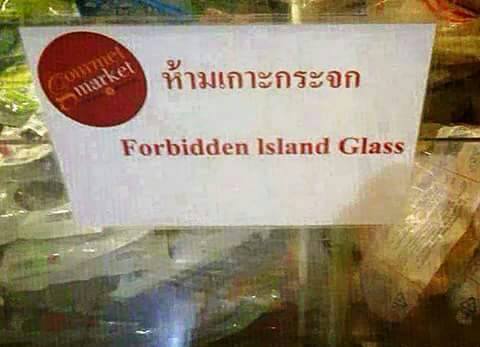Thailish
« previous post | next post »
We had just a taste of the wonders of Thai English in "Cabbages & Condoms" (10/13/15). It turns out that Thailand also offers a rich banquet of what I'll christen as "Thailish". Here's a sampling, the last of which is this mystifying sign:
H̄̂ām keāa krack ห้ามเกาะกระจก
= Forbidden Island Glass (incorrect translation)
= Please do not lean against the glass (proper English)
h̄̂ām ห้าม = forbid
keāa เกาะ = island (n.), lean (v.)
krack กระจก = glass
It looks as though we'll have to start paying attention to this upstart competitor to Chinglish.
[Thanks to Pattira Thaithosaeng]

Björn said,
October 15, 2015 @ 9:26 am
You were not the first to come up with Thailish, but I've only heard "Tinglish" before.
https://en.wikipedia.org/wiki/Tinglish
Since I live there I guess I'll keep an eye out for you.
Barclay said,
October 15, 2015 @ 9:44 am
Good to see we have new competitor to Chinglish. The translation is good, but the transcription of ห้ามเกาะกระจก as /h̄̂ām keāa krack/ is a little odd. /h̄̂ām/ is reasonably close except for the mid tone marker.
I would transcribe it as
ห้ามเกาะกระจก /hâːm kɔ̀ kràtɕòk/
ห้าม = hâːm
เกาะ = kɔ̀
กระจก = kràtɕòk
BZ said,
October 15, 2015 @ 12:45 pm
I was reading this "Forbidden Island Grass" until I read your explanation and did a double take.
Neil Dolinger said,
October 15, 2015 @ 3:12 pm
@Bjorn, Thanks for the link to Wikipedia. It's remarkable how many of the same issues exist in Chinglish. I note that the article says that consonant clusters (including ones with 'y' as the seond consonant) are not allowed in Thai, yet 'kr' is quite common. BTW, you don't have to go as far as Thailand to hear vowels inserted into English consonant clusters. In Philadelphia, one of the dominant grocery changes is named "Acme", which many locals pronounce "Ac-a-me".
@Barclay, is there a transcription system for Thai that is accepted by the majority of Thais (as pinyin is for Mandarin)?
steve Tripp said,
October 15, 2015 @ 7:29 pm
I read that as krajok.
Barclay said,
October 16, 2015 @ 7:09 am
@Neil,
The standard transcription system is the Royal Thai General System of Transcription (RTGS). This is what is used for road signs and government publications. But as a transcription system it lacks in 4 areas:
1. it does not record tones
2. it does not differentiate between short and long vowels
3. the notation (ch) does not differentiate between IPA /tɕ/ and IPA /tɕʰ/
4. the notation (o) does not differentiate between IPA /ɔ/ and IPA /o/
Numbers 1 and 2 being the biggest concerns.
Transcribing ห้ามเกาะกระจก in RTGS we have /ham-ko-krachok/
For more info the Wikipedia page on RTGS is fairly informative:
http://en.wikipedia.org/wiki/Royal_Thai_General_System_of_Transcription
Thanks,
Barclay
michael farris said,
October 17, 2015 @ 1:01 am
" the Royal Thai General System of Transcription (RTGS). This is what is used for road signs and government publications. But as a transcription system it lacks in 4 areas"
I think the main purpose of that system is to give foreign visitors who know english a vague idea of how things are pronounced and to not freak them out with extra diacritics or odd spellings. It does that job well enough though of course it's very deficient for any kind of linguistic purpose.
I used to fool around with transcription systems for Thai that were closer to Thai orthography. For this sample I might have had
háàm kö kräjok
The pronunciation can be worked out from that easily enough but it's not very user friendly (generally true of Thai orthography as well).
JQ said,
October 17, 2015 @ 1:46 pm
@m farris
In that case, certain parts of pinyin fails at giving foreign visitors an idea of how things are pronounced, while is suitable for linguistic purposes…
Anna Johnson said,
October 17, 2015 @ 3:15 pm
JQ, pinyin was designed for Mandarin speakers (literacy/"modernisation"), not visitors.
Alex Fink said,
October 17, 2015 @ 5:46 pm
The transcription H̄̂ām keāa krack is the one Google Translate gives. I've never seen its system anywhere else, nor seen Google provide any documentation on it, but it does seem to sticking very close to the Thai orthography, for instance in this case in omitting any element to transcribe the inherent /o/ after the จ c. At least they were good enough to write ke rather than ek for เก.
Sara Scharf said,
October 20, 2015 @ 9:49 pm
There are plenty of examples of mistranslations from Thai to English in the Bad Translations group on Flickr.
Here is a favourite.
Alex Fink said,
October 22, 2015 @ 2:53 am
Ivan Baines has tracked down the standard by which this transliteration H̄̂ām keāa krack was made: it's ISO 11940.